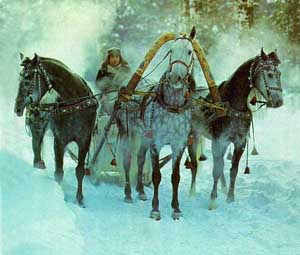дуга | Любовь и разлука / Liubov' i Razluka / אהבה ופרידה | Александр Малинин / Alexander Malinin / אלכסנדר מלינין | Lyrics Translation | Who I am | Yaniv Hamo
What is Duga (дуга) ?
 Harnessing the power of several horses, in order to allow greater speed and travel distance, was a common practice in the old times. It is quite challenging to efficiently harness the horses, to keep balance and maximum combined strength. Usually, some of the horses work harder, and some are less effective.
Harnessing the power of several horses, in order to allow greater speed and travel distance, was a common practice in the old times. It is quite challenging to efficiently harness the horses, to keep balance and maximum combined strength. Usually, some of the horses work harder, and some are less effective.
In Greece, for example, they used four horses, two of them connected to the main wooden shafts that are part of the chariot, while the other two are strapped to them. The Russian solution was to use three horses abreast, known as "Troika" (тройка) - literally, a triple. The center horse is connected firmly to both wooden shafts, under the shaft-bow, "Duga" (дуга), while the other two are strapped to it and move quite freely. This method has been customary only since the middle of the 19th century.
Both shafts and the Duga are connected to the center horse's collar using straps (гужи). These straps are tighten, between the Duga and the collar. The Duga is made of elastic wood, so after the tightening it acts as a spring, and pulls the collar away from the horse's neck, relieving the stress around its neck and shoulders. Traditionally, bells are hanged from the top of the Duga, and can be heard from a great distance while the horses gallop.
I have not yet found a proper translation of the word "дуга" to Hebrew, if you know of such, please let me know.
back